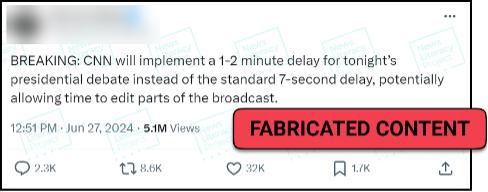
Track the trends: Disinformation disguised as ‘breaking news’
VISIT THE DASHBOARDWelcome back to our blog series focused on the Misinformation Dashboard: Election 2024, a tool for exploring trends and analysis related to falsehoods regarding the candidates and voting process.
Hours before the June presidential debate between former President Donald Trump and President Joe Biden, an X account posted a “breaking news” story claiming that CNN would implement a one- to two-minute live delay to edit footage before broadcasting it.
The claim was entirely made up, and the word “BREAKING” was used to pass it off as a credible news report. It worked. The post amassed more than 2 million views.


Standards-based news outlets use terms like “breaking news” to signal important developments in an ongoing story. But these alerts have been co-opted by purveyors of disinformation to create fake urgency and spread “breaking” news stories that are neither breaking nor news.
Watch this video compilation of some of the fake “breaking news” we’ve encountered about the election:
The Sheer Volume of Sheer Assertions
NLP’s Misinformation Dashboard: Election 2024 catalogs examples of election misinformation — tracking trends, types and themes. While propagandists have ample tools to create false and misleading content, the most widely used tactic is simply to conjure false claims out of thin air. These “sheer assertions,” as they’re known, make up about 15% of all claims in NLP’s database.


Data from NLP’s misinformation dashboard shows that “sheer assertion” is the leading tactic used to spread misinformation.
On social media, sheer assertion claims about breaking news events are among the fastest to surface and are published recklessly, before all the facts emerge. Journalists report breaking news by interviewing sources, checking data, verifying facts and updating coverage as needed. On the other hand, charlatans — many of whom claim to be doing “citizen journalism” — co-opt journalism lingo to push out baseless speculation or fabrications in mere seconds.
Newslit tip
Social media posts with breaking news language — including “breaking,” “developing,” and “exclusive” — warrant careful examination. Investigate an account’s profile to see if it is connected to a credible news outlet or has a history of publishing accurate information.
Don’t be misled by use of journalism terminology to make these alerts seem authentic. They miss two important aspects of credible reporting: multiple sources and evidence.
As Mark Twain once never said: “A lie can travel halfway around the world while the truth is still putting on its shoes.” Reliable information develops slowly during a breaking news event. Remember that bad actors attempt to fill that void with false claims.
A claim is not evidence
Along with sheer assertions, there are other rumor tactics tied to breaking news events:
- Sensational claims attributed to a single, unnamed “source.”
- Generic photographs that don’t support the claim or add to the supposed story.
- Nonsensical accusations that the media is “ignoring” a story or that a “blackout” has been issued to prevent coverage.
- False attributions to credible news outlets.
Doing real journalism is difficult and takes time. But producing falsehoods of almost any sort is comparatively easy and quick. But of all the tactics people use to spread misinformation, pushing out evidence-free assertions might require the least amount of effort. While this tactic is popular, it is also easy to spot and debunk. Just remember to check your sources, look for evidence and slow your scroll on social media to allow time for credible information to emerge.
This is part of a limited email series that analyzes trends and offers analysis based on the News Literacy Project’s Misinformation Dashboard: Election 2024. Subscribe to the series here.
